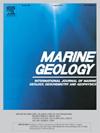Sedimentary record of water-sediment regulation and channel shifts in the Yellow River (Huanghe) Delta
Abstract
Delta are vital habitats for people and biotic communities. Many of the world's large river deltas are shrinking because of relative sea level rise and intensifying human interventions in the basin. Among these, the Yellow River Delta (hereafter YRD) has been enormously impacted by frequent channel avulsions and a Water-Sediment Regulation Scheme (WSRS) through upstream reservoirs since 2002. However, it remains undisclosed how the YRD responses to these human interventions. Here, modern sedimentation and inter-annual to multi-decadal timescales evolution of the YRD were studied using a dataset including 10 sediment cores collected in the subaqueous delta during the 2014 WSRS, satellite images, hydrographic and bathymetric data from 1976 to 2014. Our results show that the sedimentation of the delta can be divided into three stages: 1976–1995, 1996–2001, and 2002–2014. The area of subaerial delta generally increased from 3884 km2 to 4441 km2 during the whole 1976–2014 period except for a net land loss during 1996–2000. >70% of the delta coastline became artificial after 2000. Bathymetric data reveals that the subaqueous delta was seriously eroded after 1996 due to a shortage of sediment supply, with an estimated 2.3 × 108 t/yr and 1.1 × 108 t/yr of sediment respectively transported to the delta's adjacent sea during 1996–2001 and 2002–2014. The deltaic sediment became coarser due to the impact of the WSRS. Radionuclide 7Be uncovers a rapid sediment accumulation of ∼12 cm at the active delta front during the 2014 WSRS. The evolution of the YRD has become complex under the influence of natural and anthropogenic factors. The YRD thus provides an exemplar shift from natural to human-dominated delta. These results are important for the delta management decision making.

 求助内容:
求助内容: 应助结果提醒方式:
应助结果提醒方式:


